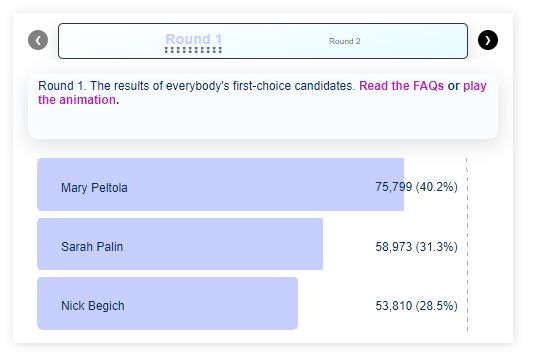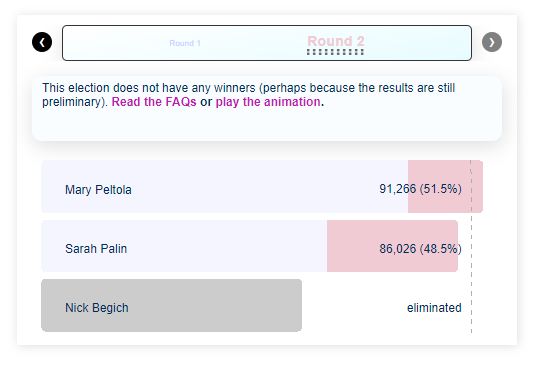Alaska held its first ranked choice voting (RCV) election on August 16th. Ranked choice voting gave Alaskans better choices and more competition on election day. This was a tight three-way race where Alaskan voters were able to have more choices than a partisan battle between two candidates.
Mary Peltola won the election with 51.5% in the final round, according to unofficial results on August 31st.


Peltola built on a strong first-round lead. Mary Peltola led by 9 points among first choice preferences, and also earned enough second-choice rankings to hold on to her lead. Peltola clearly had deep support, evidenced by her strong first-choice lead, and broad support, evidenced by her ability to earn second-choices from Begich supporters.
Peltola’s issues-oriented messaging resonated with voters. Peltola ran a mostly positive, issues-focused campaign and she made attempts to connect with voters across the political spectrum. Her campaign included a focus on Alaskan fisheries and some level of openness to oil and gas exploration (not a typical Democratic position.)
Come-from-behind wins remain rare in RCV. This election matches most of our experience with RCV. In the past, only 4% of RCV elections resulted in a come-from-behind winner. The greatest “comeback” margin in an RCV tabulation was ten points (i.e. the ultimate winner trailed the 1st-choice leader by ten points) so a lack of a comeback win in this race matches expectations.
Begich voters split on their 2nd choice. When Nick Begich was eliminated, 50% of Begich voters ranked Palin second; 29% crossed party lines and ranked Mary Peltola; and 21% chose not to rank a second choice. This means 79% of Begich voters ranked a second choice. In other RCV elections, 71% of voters typically rank multiple candidates.
Anti-RCV messaging probably harmed Palin. Palin went negative quickly this campaign, and repeatedly spoke out against ranked choice voting. Ranked choice voting incentivizes collaboration while disincentivizing negative campaigning. Voters take cues from candidates, and results in New York and Maine tell us voters may be less likely to use their backup choices for candidates who speak out against RCV. This made it tougher for Palin to convince Begich supporters to rank her as their 2nd choice.
High voter turnout. Voter turnout was higher than the last 3 primaries in Alaska.
Voters understand the system and like these reforms. According to a new poll from Patinkin Research Strategies, 85% of Alaskans said ranking is simple and 95% said they received instructions on how to complete their ranked choice ballot – indicative of the Alaska Division of Elections’s great voter education efforts. 62% of Alaskans support the state’s new primary system that is open to all voters and allow the top-four vote getters to advance to the general election with RCV.
99.8% of ballots cast were valid. This is no surprise – other RCV exit polls also tell us that voters like ranked choice voting once they use it.
Preview of the November rematch: These three candidates will face off again in just three months, probably joined on the ballot by Libertarian Chris Bye. (The recent election was a special election to fill the vacancy created by the passing of former Representative Don Young. The winner will only serve until January.) We can expect higher turnout in November. Other things to watch for:
- Will Peltola’s lead grow after she spends a few months in Washington?
- Can newcomer Libertarian Chris Bye earn enough support to pass one of the other three candidates and avoid being eliminated in the first round?
- Will any campaigns shift their strategy? Remember, anti-RCV messaging on the campaign trail can hurt candidates because voters pick up on that messaging and it can hurt a candidate’s chances.
Deb Otis is the Director of Research at FairVote. With a decade of experience in research and analytics, Deb is passionate about sharing the data-driven case for why our country needs election reform. In addition to ranked choice voting and proportional representation, Deb's areas of research include comparative electoral systems, political polarization, redistricting, representation for women and people of color, the electoral college, and election recounts. Deb is a graduate of Boston University with degrees in Economics and Physics and she lives in Washington, DC.
About FairVote
Our Mission: FairVote is a nonpartisan organization seeking better elections for all. We research and advance voting reforms that make democracy more functional and representative for every American.
What We Do: FairVote has a proven record since 1992 as a nonpartisan trailblazer that advances and wins electoral reforms at the local, state, and national level through strategic research, communications, and collaboration. Today, we are the nation's driving force behind advancing ranked choice voting and fair representation in multi-winner legislative districts that will open up our elections to better choices, fairer representation, and more civil campaigns. See recent year-end reports that detail our impact.
30 Years of Impact: In 2022, FairVote is celebrating 30 years of innovation and impact and we're looking forward to a coming decade of promise. Important and exciting work lies ahead to win ranked choice voting everywhere, pass the Fair Representation Act, and transform our nation's elections together. We hope you'll join and support us.


Spread the word